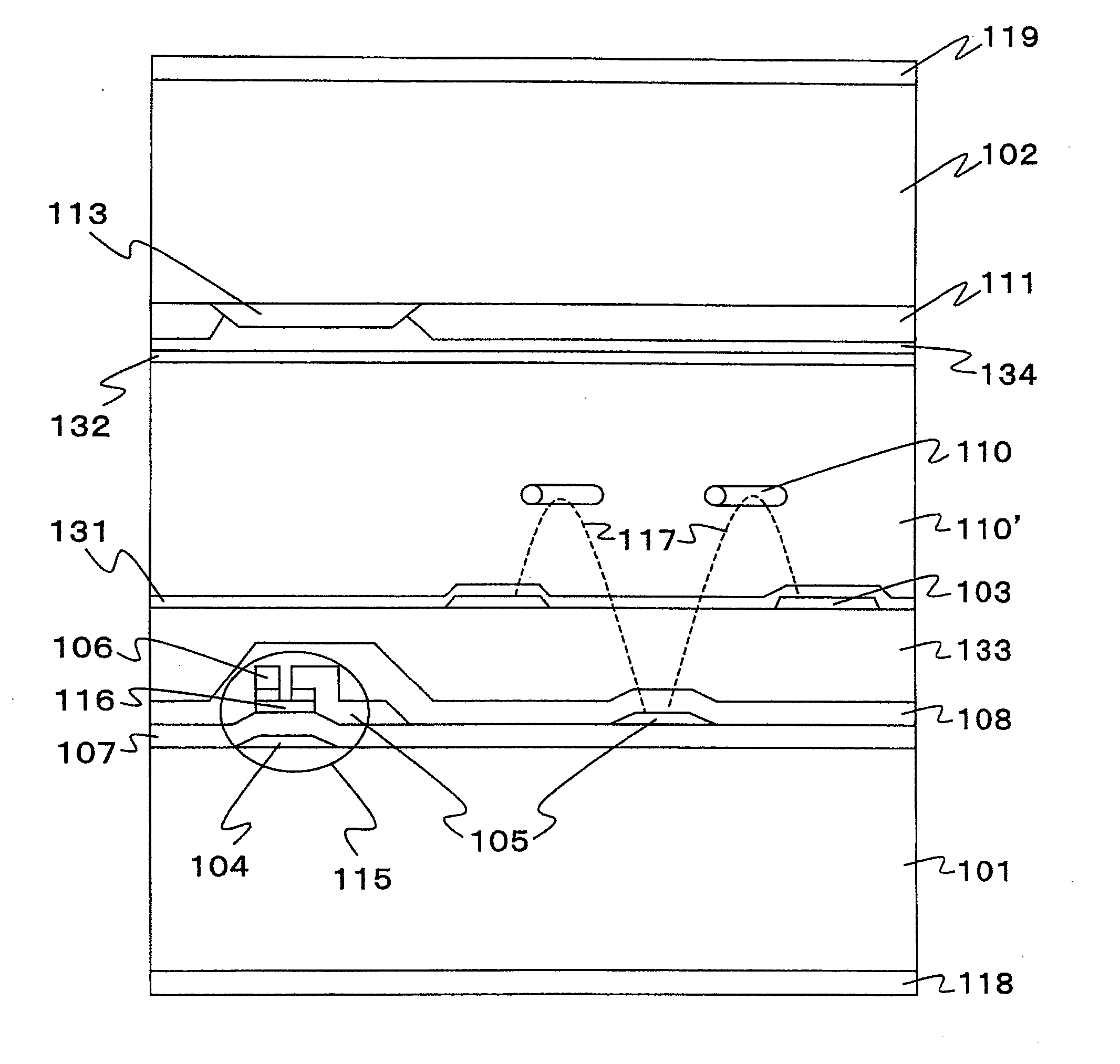Liquid Crystal Display Device
- Summary
- Abstract
- Description
- Claims
- Application Information
AI Technical Summary
Benefits of technology
Problems solved by technology
Method used
Image
Examples
first embodiment
[0066]FIG. 1 is a schematic cross-sectional view of the vicinity of a pixel which illustrates a first embodiment of the liquid crystal display device of the present invention. FIG. 2 is schematic views of an active-matrix substrate for explanation of the structure of the vicinity of a pixel which illustrate the first embodiment of the liquid crystal display device of the present invention. FIG. 2(a) is a plan view, FIG. 2(b) is a sectional view taken along the line A-A′ in FIG. 2(a), and FIG. 2(c) is a sectional view taken along the line B-B′ in FIG. 2(a). FIG. 1 corresponds to a part of a section along the line A-A′ in FIG. 2(a). The sectional views as FIG. 2(b) and FIG. 2(c) are schematic views in which the structure of the main portion is emphasized, and they do not correspond to the sections along the line A-A′ and the line B-B′, respectively, in FIG. 2(a) in an one-by-one manner. For example, in FIG. 2(b), a thin-film transistor 115 is not shown, and in FIG. 2(c), only a portio...
second embodiment
[0079] A second embodiment of the liquid crystal display device of the present invention is explained below. FIG. 3 is a schematic cross-sectional view of the vicinity of a pixel which illustrates the second embodiment of the liquid crystal display device of the present invention. FIG. 4 is schematic views of an active-matrix substrate for explanation of the structure of the vicinity of a pixel which illustrates the second embodiment of the liquid crystal display device of the present invention. FIG. 4(a) is a plan view, FIG. 4(b) is a sectional view taken along the line A-A′ in FIG. 4(a), and FIG. 4(c) is a sectional view taken along the line B-B′ in FIG. 4(a). FIG. 3 shows a part of a section along the line A-A′ in FIG. 4(a). The sectional views as FIG. 4(b) and FIG. 4(c) are schematic views in which the structure of the main portion is emphasized, and they do not correspond to the sections along the line A-A′ and the line B-B′, respectively, in FIG. 4(a) in an one-by-one manner. ...
third embodiment
[0089]FIG. 5 is a schematic cross-sectional view of the vicinity of a pixel which illustrates a third embodiment of the liquid crystal display device of the present invention. In FIG. 5, the same symbols as in the drawings in the embodiments described above correspond to the same functional portions as in these embodiments. As shown in FIG. 5, in the present embodiment, a pixel electrode 105 located under a protective film 108 is drawn up to the surface of an organic insulating film 133 through a through-hole 118 to be located at the same level as that of common electrodes 103. When this structure is used, a voltage for driving liquid crystals can be further reduced.
PUM
| Property | Measurement | Unit |
|---|---|---|
| Nanoscale particle size | aaaaa | aaaaa |
| Nanoscale particle size | aaaaa | aaaaa |
| Wavelength | aaaaa | aaaaa |
Abstract
Description
Claims
Application Information
 Login to View More
Login to View More - R&D
- Intellectual Property
- Life Sciences
- Materials
- Tech Scout
- Unparalleled Data Quality
- Higher Quality Content
- 60% Fewer Hallucinations
Browse by: Latest US Patents, China's latest patents, Technical Efficacy Thesaurus, Application Domain, Technology Topic, Popular Technical Reports.
© 2025 PatSnap. All rights reserved.Legal|Privacy policy|Modern Slavery Act Transparency Statement|Sitemap|About US| Contact US: help@patsnap.com



